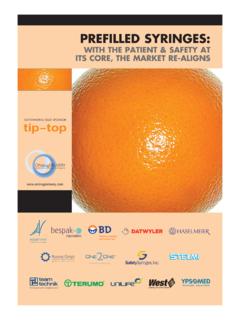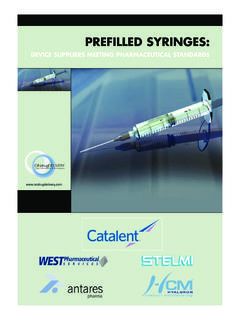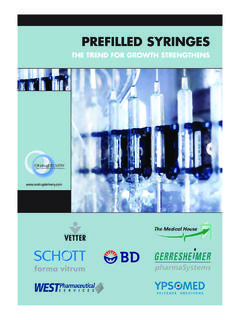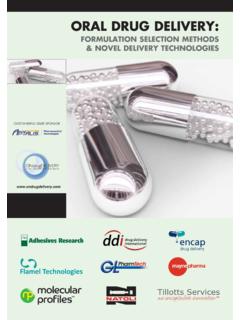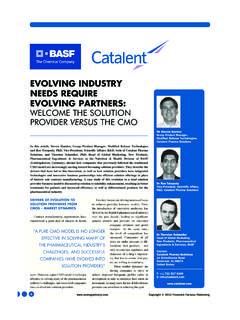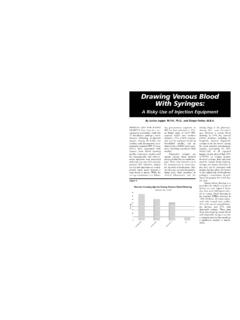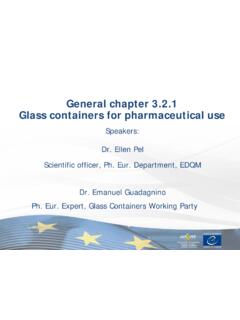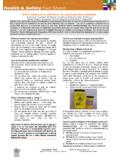Transcription of PREFILLED SYRINGES FOR VISCOUS FORMULATIONS
1 Copyright 2013 Frederick Furness Publishing Ltd this article, Mahesh Chaubal, PhD, Senior Director, Drug Development, R&D Medical Products, Baxter Healthcare Corporation, provides a glimpse of some of the challenges faced dur-ing the development of VISCOUS FORMULATIONS of biopharmaceutical products for injection, from a formulator s perspective, especially when the finished product is filled in a PREFILLED SYRINGES FOR VISCOUS FORMULATIONSP refilled SYRINGES represent a patient-friendly and compliant way to administer drugs in an alternate setting such as the home. This makes them an appropriate device for drugs that are administered chronically. PREFILLED SYRINGES have gained popularity over last two decades due to the emergence of biologics as a major class of injectable Today, biologics are used for the treatment of various acute and chronic conditions.
2 For chronic conditions, the final dosage form should be patient friendly, such that the patient can self-administer and avoid the costs of using a healthcare provider. However, a downside of chronically administered drugs is the frequency of injections. In an effort to reduce the frequency of injections, formulators often try to load a significant dose in a single injection that must then be delivered. High-dose FORMULATIONS pose significant challenges from a formulation and fill-finish perspective. Typically, drug stability over the duration of the product s shelf-life is a formulator s main focus. However, when developing dosage forms for self-administration, additional factors have to be taken into consideration. These include performance of the device over the shelf-life, and the human factor aspects of the device usability.
3 The importance of the latter is visible in the US FDA s guidance on using human factors for medical For VISCOUS FORMULATIONS , device performance and human factors become even more important, given that a VISCOUS formulation may be harder to administer via a PREFILLED syringe. The interplay between these various factors is demonstrated in this brief case study for developing a VISCOUS formulation in a PREFILLED syringe PERSPECTIVEHigh-concentration drugs that are administered chronically are formulated to provide sustained release. This can be achieved via either the use of a release rate modifier or intrinsically long half-life of the drug. Release-rate modifiers include polymers formulated as microspheres or gels, as well as oily depots wherein the drug is dissolved in pharmaceutically acceptable oil.
4 In each case, the release-rate modifier (or high concentration of the drug) result in a formulation that has high Figure 1 lists some of the potential drug FORMULATIONS that involve high viscosity. When dealing with highly VISCOUS FORMULATIONS , the end-user perspective is important upfront at the formulation development stage. Highly VISCOUS FORMULATIONS cause challenges during various process steps, such as transfer operations (pumping) and Dr Mahesh V. ChaubalSenior Director, Drug Development, R&D Medical ProductsT: 1 847 270 6657 Baxter Healthcare Corporations25212 W. Illinois Route 120 Round LakeIL 60073 United of VISCOUS formulationExample productPolymer-solvent gelsEligardPolymer solutionsHyalganOily formulationsFaslodexMicrospheresLupron depotHigh concentration MAbsKineret (150 mg/mL) Figure 1: Table listing examples of marketed high viscosity FORMULATIONS available in PREFILLED SYRINGES .
5 Copyright 2013 Frederick Furness Publishing Ltdfiltration, among others. If the final container closure is a PREFILLED syringe, then high viscosity can also cause problems with the syringeability of the final or injectability is the ability/ease by which a formulation can be dispensed out of a syringe. Currently, no harmonised approach exists for testing the syringeability of a drug. Limited literature data is available that describes various approaches for evaluating Formulators often mistakenly assume a direct correlation between syringeability and viscosity and hence use viscosity of the drug solution as a surrogate measure of syringeability. In this study, syringeability from a BD Hypak glass PREFILLED syringe was measured directly using the Hagen-Poiseuille equation, which is used to assess the pressure differential across a pipe during flow.
6 In this case, flow through a needle as the formulation is pushed out is analogous and hence justifies the use of this equation: P = 8QL / r4 where P is the pressure across the needle, Q is the injection speed, is the viscosity of the formulation, L is the length of the needle and r is the radius of the needle. As can be seen in Figure 2, during formulation optimisation studies for an oily depot formulation, a direct correlation could be obtained between the viscosity of the formulation and the respective syringeability of the product from a PREFILLED syringe. In order to assess the viability of syringing this VISCOUS formulation, the viscosity of the formulation was compared with other VISCOUS products. Figure 3 shows that when the viscosity of the formulation was compared with another commercially available VISCOUS product, Hyalgan (sodium hyaluronate; Fida, Italy), it was observed that while the two FORMULATIONS had similar viscosity, there was a significant difference in their syringeability.
7 Hyalgan is a formulation of hyaluronic acid which is a thixotropic polymer Hence viscosity of the formulation decreases during the syringing process. Another product listed in Figure 1, Eligard (leuprolide acetate; Sanofi, France), utilises the shear thinning property of poly(lactic-co-glycolic acid) (PLGA) solutions to reduce the viscosity of the formulation prior to This demonstrates that while viscosity is an important formulation parameter, it is not always indicative of the syringeability of the product and hence specific studies are required in the PREFILLED syringe of the high syringeability forces required for the test article, the formulation was modified by changing the oil-drug ratio and also by adding a solvent to reduce viscosity. This resulted in a formulation that demonstrated acceptable forces for syringeability of the product through a typical BD Hypak glass SYRINGES are a preferred container closure system for delivery of chronically delivered FORMULATIONS , due to ease of administration in an alternate setting, such as at home.
8 However, this format adds complexities, compared with the conventional vial format. This report provides a case study of the interplay between formulation development and fill-finish configuration development. It is essential for the two activities to occur simultaneously to develop an effective product. In this specific case, an effective formulation in PREFILLED syringe was developed by manipulating the oil-to-cosolvent ratio of the oily depot formulation. Use of the appropriate fill-finish partner is important in developing such complex FORMULATIONS . Baxter s BioPharma Solutions business has in-house capability to support formulation development and fill-finish aspects of VISCOUS FORMULATIONS in PREFILLED Adler M, Challenges in the Development of Pre-filled SYRINGES for Biologics from a Formulation Scientist s Point of View.
9 Am Pharm Rev, Vol 15(1), Feb Use of human factors for medical device evaluation. ( )3. Larsen S, Thing M, Larsen C, In Long Acting Injections and Implants J. Wright and D. Burgess (Eds), Adv Del Sci & Tech, 2012, Cilurzo F, Selmin F, Minghetti P, Adami M, Bertoni E, Lauria S and Montanari L, Injectability evaluation: an open issue . AAPS PharmSciTech, 2011 (June), Vol 12(2), pp604 609. 5. Allahham A, Mainwaring DE, Stewart P, Marriott J, Development and application of a micro-capillary rheometer for in vitro evaluation of parenteral injectability . J Pharm Pharmacol, 2004, Vol 56, pp709 Chien YW, Przybyszewski P, Shami EG, Syringeability of nonaqueous parenteral FORMULATIONS --development and evaluation of a testing apparatus.
10 J Parenter Sci Technol, 1981, Vol 35(6), pp281 Matteini P, Dei L, Carretti E, Volpi N, Goti A, Pini R, Structural behavior of hyaluronan under high concentration conditions . Biomacromolecules, 2009, Vol 10(6), Eligard prescribing insert, Sanofi-Aventis US LLC, DPInstron Force Measurement (N)CppsiMean force, 1 mL Mean force 2: Relationship between viscosity and syringeability for an oily formulation injected using a glass PREFILLED 3: Comparison of viscosity and syringeability of an oily depot formulation with a commercial VISCOUS (cs)y= (psi)200250300 Best Contract Manufacturing Organization BioPharma Solutions Wins Best CMO at Vaccine Industry Excellence Awards For Three Years Consecutively (2010, 2011, 2012)920810-00 1/12 For more information, visit us at ICSE 2013 Booth 42G21baxter 130/09/2013 22:27
